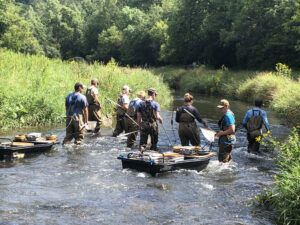Flowing through the city of River Falls, the Kinnickinnic River is a class I trout stream that also is home to two dams that have generated the city’s hydroelectric power for decades.
When the River Falls community decided to remove the dams and restore the riverway, the Kiap-TU-Wish chapter of Trout Unlimited and Inter-Fluve, a firm specializing in river restoration, developed an extensive 10-year monitoring plan for the project. The plan was provided to the City of River Falls and the Kinni Corridor Collaborative, a nonprofit that is leading fundraising efforts for the dam removal and river restoration work.
“When the city council decided to remove the dams in 2018, the resolution stated there should be a monitoring plan and ongoing monitoring to determine effectiveness,” says Kent Johnson of Trout Unlimited. “Monitoring the removal of the first dam would inform removal of the second dam.”
Due to budget constraints, the plan initially relied upon volunteers to conduct the monitoring. That created potential challenges in terms of reliability, consistency of the data collected and the ability to provide long-term monitoring.
That’s when an ongoing research partnership with UW-River Falls faculty and staff came into play. Why not use the monitoring project to provide undergraduate students with hands-on training while also fulfilling a community need?
Jill Coleman Wasik, associate professor at UW-River Falls, and Heather Davis, lab manager, requested a grant from the Freshwater Collaborative of Wisconsin to create “The Dam Analysis and Monitoring (DAM) Crew,” a two-week student experience during which working professionals would train undergraduates in monitoring techniques.
“Trout Unlimited and the Kinni Corridor Collaborative wanted scientifically valid data. They couldn’t just rely on volunteers to come in any day and collect data,” Coleman Wasik says. “The funding from the Freshwater Collaborative came at a critical time for the monitoring plan and allowed our faculty and students to meet an identified need.”

Five UW-River Falls students and one from UW-Eau Claire were selected to work on the DAM Crew. Sean Morrison, a geomorphologist at Inter-Fluve and a graduate of UW-Eau Claire, trained them on several technical skills with a focus on data collection, which is an essential skill his company looks for when hiring. During the first week, the students often spent eight hours a day in waders, collecting samples.
Trout Unlimited has been monitoring the impacts of the city’s dams and storm water discharges since 1992, so Johnson shared historical data and demonstrated Trout Unlimited’s macroinvertebrate monitoring as well as a phone app (WiseH2O) the organization uses for water quality and temperature monitoring.
The students weren’t told the dams would be removed. Instead, Davis led them through a process of inquiry during which they were given basic information, made observations at the sites and analyzed data they collected. Students looked at water-quality parameters, temperature and stream ecology as well as legal and economic aspects of the project. They then presented their conclusions and recommendations to stakeholders.
“The students concluded the dams should be removed,” Davis says. “They talked about strategies for dealing with the dams after they’re drained and ways to make a community space that’s healthy for the river and the community.”
Those involved agree the DAM Crew project strengthened connections between UW-River Falls and the community. The university was able to exemplify the Wisconsin Idea by actively participating in a community project, and community partners had the opportunity to work with future water professionals. Students received hands-on training and networking opportunities — and saw how their research could solve real problems.
“It’s easy to do the science but not know if it matters,” says Zach Blackert, an environmental geography major who will graduate from UW-Eau Claire in May. “I got to really see how important the science is to the entire city and the entire watershed. And I feel a lot more prepared to enter the workforce.”
As part of the grant, Jordyn Curtis and Mckenna Kellogg were hired as interns to continue data collection during the spring semester. They also will be able to conduct research into soil cores, sedimentation and vegetative cover, which will further inform the river restoration and lay the groundwork for future student research.
“I’m very appreciative they gave us the opportunity to continue the study from the summer,” Kellogg says. “They trust us with this independent research and believe in us to be able to create a framework for future interns.”
Curtis adds: “We’re pioneers. It will be good for future students, and I think it’s good it’s here at UW-River Falls.”
The goal is for the DAM Crew to conduct river monitoring each summer and provide ongoing data and recommendations to the community partners.
“It’s very rare that we’re able to do anything beyond photo monitoring. Monitoring is always one of the first things to get cut from the budget,” Morrison says. “The Freshwater Collaborative funding did a great job of helping to train the next generation of water resource professionals, and it provided us with a dataset that will provide really unique insights.”

